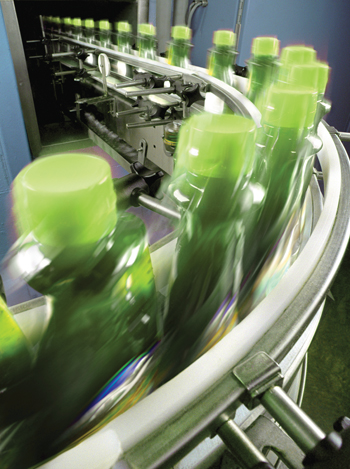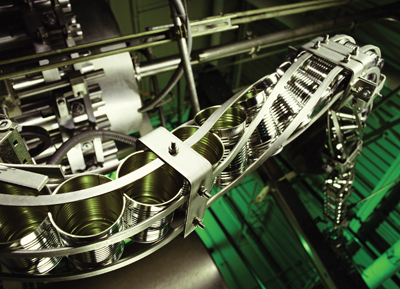|
||||||||||||||||||||||||||||||||||||||||||
|
||||||||||||||||||||||||||||||||||||||||||
Trigger-to-Image Reliability: making the difference in manufacturing systems

Machine vision systems are being used for quality control (inspection) and guidance in a variety of manufacturing industries, including wood, paper, pharmaceutical, medical devices, automotive, electronics and semiconductors. OEMs that develop machine vision systems built upon Coreco Imaging's products strive to produce solutions that are robust enough to withstand even the harshest industrial manufacturing environments and to deliver reliable results under a variety of operating conditions.
Designing highly reliable and robust machine vision systems is not an easy task. That is why - based on their years of experience developing vision products for industrial applications - Coreco Imaging's engineers have implemented Trigger-to-Image Reliability in our newest vision boards, including the X64 and PC2-Vision Series. This article discusses the meaning of Trigger-to-Image Reliability, its various aspects and how it benefits OEMs and end users alike.
What is Trigger-to-Image Reliability?
Trigger-to-Image Reliability ensures highly reliable acquisition control throughout the image capture and processing sequence, from the time that a trigger is fired (part in place) to the time the image is transferred to the host computer for processing to the time a decision is made to accept or reject the part. This level of dependability is accomplished by integrating various image acquisition control functions - including trigger inputs, strobe outputs, camera control signals and external I/O - onto onboard hardware and using software API functions for command and control.
Acquiring the Right Target
Coreco Imaging has incorporated various camera control functions into the design of its machine vision frame grabbers. A good starting example is the integration of the trigger and strobe control functions into onboard hardware. This sounds simple enough: a trigger input generates a strobe output for lighting control and camera exposure. However, there are circumstances in which a delay between the trigger input and the strobe output is required; for example, if the camera and lighting units are not in the same position on the conveyor as the trigger sensor. Coordinating these two events through software (especially given the variations of the Windows®operating system) is almost impossible and certainly not reliable.
Therefore, Coreco Imaging has also incorporated programmable delay timers between these two signals. The delay timers give developers a mechanism for establishing a deterministic delay between the trigger input and firing of the lighting and camera exposure. However, this amount of programmed delay is predicated on the theoretical speed of the production line. If the actual speed is not constant (which is very common), then the camera will not acquire the target properly. Therefore, another feature of the integrated trigger and strobe mechanism establishes the delay according to shaft encoder ticks, i.e., linking the delay to the actual speed of the production line. Not only is the delay deterministic, it is fixed to the location of parts on the production line, regardless of how fast they are moving.
Through these and other hardware features, the first aspect of Trigger-to-Image Reliability is achieved: the camera is properly controlled to capture the image of the target being inspected. Of course, these hardware features are under software control, but, once initialized, they act independently of any software execution, leading to deterministic results.
Triggers, Triggers and More Triggers
A reliable and repeatable mechanism for target acquisition onto the camera sensor can be obtained using the camera control features described above. What remains is the ability to read this data from the sensor and to transfer this data to the host computer for processing. The Trigger-to- Image Reliability capability incorporates control signals that enable sensor data to be read into the machine vision frame grabber.
However, first we have to ask ourselves if we have handled all of the conditions that could potentially occur to make our system unreliable. The first condition that we have not considered is the possibility that the sensor never detected the object in the first place, and therefore has not generated a trigger signal to the system. Although this condition might seem to fall outside the scope of Trigger-to-Image Reliability, Coreco Imaging is working with specific camera vendors to utilize fast and partial scan modes of new camera models to detect potentially missed targets. While Coreco Imaging's customers can look forward to this feature in the future, for the moment designers do need to provide a reliable triggering mechanism.
Other situations that can occur include too many triggers (as in false triggers), or triggers that follow too closely to one other and do not allow the system to read the sensor completely before the next exposure takes place. Trigger-to-Image Reliability handles these situations by notifying the host application of missed triggers through event callbacks. In such scenarios, the machine vision application is made aware of the double trigger and can take appropriate action, such as automatically rejecting the target into the "not inspected" bin, or flagging the error for a human operator to review.
The Importance of Time Stamps
While we have progressed to the point of detecting our targets, firing the strobes and camera when the target is in the right location and reading the correct data from the sensor, this is only the start of designing a reliable machine vision system. Another major issue is coordinating the collection of image data and correlating these images with physical objects moving through a material-handling system. To illustrate, let's use an example of a material-handling unit processing up to 3,600 parts per minute (ppm). The machine vision system's task is to inspect the surface of the manufactured good on all sides (four views). An additional constraint is that, due to the physical infrastructure of the machinery, not all four images can be acquired at the same physical spot, but are acquired individually as the target moves through the system.
In this scenario, the imaging system must acquire 14,400 images per minute and correlate four different acquisition locations with the image data stream. And, as the object emerges from material handling, a decision must be made regarding whether to accept, reject or re-inspect the object. Trigger-to-Image Reliability introduces another very important concept designed to assist engineers in creating reliable and repeatable systems: the time stamp. A time stamp encodes a unique time code into the image data structure. This time code is either generated from an onboard hardware clock or is derived from shaft encoder ticks. The time stamp provides a direct correlation between the movement of the target through the system and the data being acquired. Since there is a time lag between image capture and analysis, the time stamp code ensures that the system acts on the correct target.
Another useful feature of the time stamp is in the application of long or high speed image sequences. In this scenario, the time stamp between images can be analyzed to determine if an image was missed during a capture sequence.

Monitoring the Acquisition Process in Host Memory
Now the machine vision system is capturing the right data and tracking objects throughout the cycle, thereby rejecting or accepting the right component. It is now time to transfer the image data to system memory reliably. In order to implement this process, Trigger-to-Image Reliability delivers another set of software tools that ensures that all required images were captured accurately onto the frame grabber. By utilizing the series of events described in the table below, the system designer can accurately monitor the capture and transfer sequence into system memory:
Through these events, the host application can monitor the target acquisition process, from the time the object is in place to the time that the image resides in host memory. In order to assist the OEM in the monitoring process, each event is placed in the context of a specific channel, and is therefore related to one camera. Within each context (or channel), an index counter is maintained and incremented on each event. Therefore, if an index value is incorrect, the user can immediately ascertain that an error has occurred.
Running Too Fast
Let's jump back to the scenario of the machine vision system acquiring, processing and analyzing 21,600 images per minute. Proper system design dictates that a certain amount of over-capacity is built into the system to handle peak loads. In the case of a machine vision system, a peak load could occur while attempting to monitor system variables during image processing on thousands of images. Trigger-to-Image Reliability delivers peak load capacity through the concept of circular buffers. By depositing image data into the next available buffer within the circular buffer, multiple images within a context can be maintained.
The worst-case scenario occurs when the system cannot process images quickly enough to open buffer space. In this situation, Trigger-to-Image Reliability will deposit the image data into a special frame buffer called the "trash buffer." At the same time, a hardware event is generated indicating that there is image data in the trash buffer that must be monitored. A partial recovery for the machine vision application in this scenario would be for the application to read the image time stamp and to track that object through the system for rejection into the "not inspected" bin.
Ensuring Data Quality
Trigger-to-Image Reliability has progressed from ensuring that the target is acquired to correlating targets with image data to verifying that reliable image data is transferred and processed into system memory. However, several additional measures are necessary to deliver a truly robust and reliable system. So far, no mention has been made about the quality of the data acquired from the camera. What would happen if a noise or power glitch merged two pixels or lines together? Does this mean that all further data acquisition is incorrect and the system must be restarted?
Trigger-to-Image Reliability resolves this issue by comparing the number of pixels and lines being captured to the camera file. If an error has occurred, obliterating some camera data, Trigger-to-Image Reliability will recover on the next incoming image. Simultaneously, a status flag indicating the quality of the image acquired from the camera is set and encoded into the image structure.
Conclusion
Trigger-to-Image Reliability benefits OEMs and end users in the development of high speed, high-volume applications in which machine vision systems need to be able to detect defective objects and reject them from the production line quickly and reliably. OEMs have the peace of mind that the frame grabber will make their systems more robust and reliable. In addition, development is greatly simplified, since OEMs don't have to invest time and effort into trying to understand why a system failed or will fail, as the frame grabber itself will detect problems and take corrective action. Trigger-to-Image Reliability also reduces maintenance and support once the equipment is in the field, leading to lower total system costs.
Trigger-to-Image Reliability saves end users extensive time and money
by increasing uptime and productivity. As many industries, such as semiconductor,
move toward 100% inspection, Trigger-to-Image Reliability helps these
manufacturers achieve better product yields at the lowest possible production
costs.
For more information please contact us.
|
If you like this page, please recommend and share it. |
|||
| More | |||



